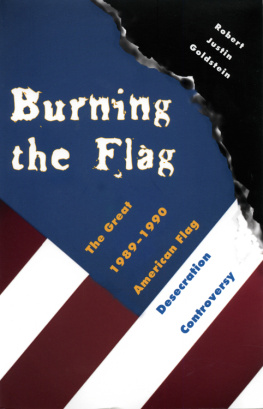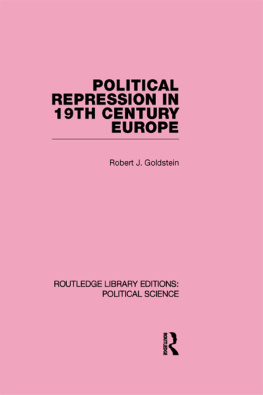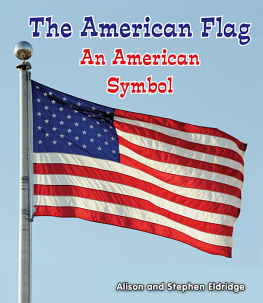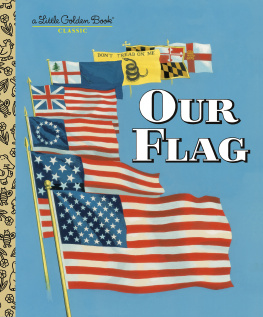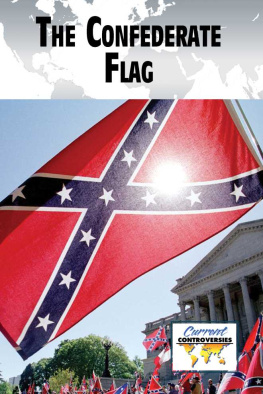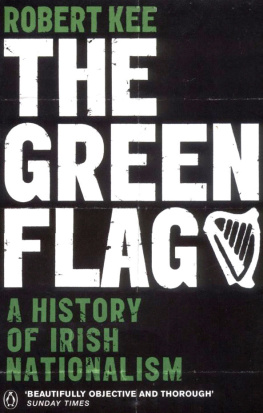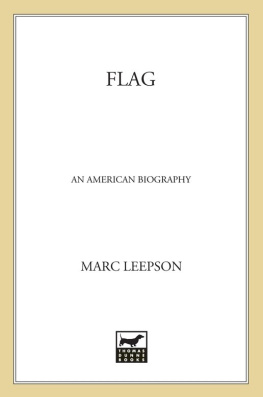First published 1995 by Westview Press
Published 2019 by Routledge
52 Vanderbilt Avenue, New York, NY 10017
2 Park Square, Milton Park, Abingdon, Oxon OX14 4RN
Routledge is an imprint of the Taylor & Francis Group, an informa business
Copyright 1995 by Taylor & Francis
All rights reserved. No part of this book may be reprinted or reproduced or utilised in any form or by any electronic, mechanical, or other means, now known or hereafter invented, including photocopying and recording, or in any information storage or retrieval system, without permission in writing from the publishers.
Notice:
Product or corporate names may be trademarks or registered trademarks, and are used only for identification and explanation without intent to infringe.
Library of Congress Cataloging-in-Publication Data
Goldstein, Robert Justin.
Saving "Old Glory": the history of the American flag desecration
controversy / Robert Justin Goldstein.
p. cm.
Includes bibliographical references and index.
ISBN 0-8133-2325-8
1. FlagsUnited StatesDesecration. I. Title.
CR113.G57 1995
929.9'2'0973dc20
94-29362
CIP
ISBN 13: 978-0-367-28659-0 (hbk)
WRITING to a German friend who had expressed doubt about the importance of flags, Theodore Herzl (1860-1904), the Austrian Jew who is today regarded as the founder of modern Zionism, declared:
You might ask mockingly: "A flag? What's that? A stick with a rag on it?" No sir, a flag is much more. With a flag you lead men, for a flag, men live and die. In fact, it is the only thing for which they are ready to die in masses, if you train them for it. Believe me, the politics of an entire people ... can be manipulated only through the imponderables that float in thin air.
Certainly the importance of a flag for both political leaders and the general population of an entire nation was rarely demonstrated so clearly as in the United States in 1989-90, when a controversy over whether it should be legal to burn the American flag for the purpose of expressing political dissent became a dominant item on the political agenda for an entire year. During this period, the U.S. Supreme Court twice declared that such conduct was protected by the First Amendment to the Constitution, massive public majorities expressed disagreement with this point of view in opinion polls, and the president of the United States unsuccessfully urged the passage of a constitutional amendment to overrule the Court. The Congress of the United States, after literally thousands of pages of hearings and floor debate, rejected such an amendment in both 1989 and 1990. However, in 1989 Congress overwhelmingly passed a law that sought to overturn the Court's original 1989 decision. After the Court declared the new law unconstitutional in a second decision in 1990, the entire issue disappeared almost immediately, no doubt partly because few people actually ever witnessed a protest flag burning or were truly affected in their daily lives by such an almost purely symbolic issue. Moreover, public opinion by then appears to have turned away from what had in effect become a "summer re-rerun" to far more concrete issues, such as economic and budgetary problems and the crisis that developed after the Iraqi invasion of Kuwait in August, 1990.
This book primarily focuses upon developments related to the American flag desecration controversy prior to the 1989-90 furor. Although it originated as a study of the 1989-90 controversy, as I began to dig in to the historical background to that dispute, it became clear that the issue had deep, and largely unexplored, historical roots that cried out for excavation. There had been a similar controversy over symbolic flag protest during the Vietnam Waras I vaguely remembered from having lived through it. It also became clearas neither I nor anyone else seemed to recallthat the American debate over flag desecration actually dated from the late nineteenth century.
It was during this time that the first laws outlawing flag "desecration" were passed and enforced (by states rather than the federal government) and when the first debate over the wisdom of such action de velopedlaws that (sometimes in revised form) later led to the numerous flag desecration prosecutions of the Vietnam War era and ultimately to the prosecution of Gregory Lee Johnson for a 1984 flag burning in Dallas that touched off the 1989-90 ruckus.
As I continued to dig deeper into the origins of the 1989-90 flag desecration controversy, I increasingly uncovered what struck me as a neglected treasure trove of largelyand often completelypreviously ignored pamphlets, court decisions, legislative debates, and other materials from the pre-1989 period. However, especially because neither the original turn-of-the-century flag desecration controversy nor the Vietnam-era controversy have ever before been the subject of an in-depth study, it gradually became clear that attempting to compile a comprehensive account of the American flag desecration from its origins through the 1989-90 dispute would produceand in fact at one point did producea volume so large that it could not be feasibly priced, read, or probably even lifted.
Fortunately for me, and, I hope, for my readers, editor Peter Kracht of Westview Press encouraged me to carve out of my original manuscriptwhich ran 1,400 pages in typescripta smaller book that would primarily treat the origins and development of the flag desecration controversy leading up to 1989, while including in a lengthy summary of the 1989-90 dispute in order to provide historical completion to the study. Again, fortunately for me and I hope for my readers, Kent State University Press subsequently agreed to publish what was, in effect, the second half of the original manuscript as a separate book that focuses on the 1989-90 debate, and which will be published under the title of Burning the Flag: The Great 1989-90 American Flag Desecration Controversy.
In the process of writing what turned out to be two separate books on the history of the American flag desecration controversy, I collected approximately 30,000 pages of documents and eventually put together yet a third volume consisting of an edited and annotated collection of documents selected from these sources, which had provided the raw material for my research. This third book will be published by Syracuse University Press under the title of The American Flag Desecration Controversy, A Collection of Key Documents from the Civil War to 1990. (Three documents from this collectiona model law that became the template for many of the flag desecration laws that were passed by all of the states between 1897 and 1932, and the texts of the 1968 and 1989 federal flag desecration lawsare printed as an appendix to the book because their exact contents are critical to much of this narrative.) Happily, all three presses have agreed with me that these books complement, rather than compete with one another, and therefore have kindly pursued their individual volumes while still encouraging me to continue working on their scholarly "brothers."



